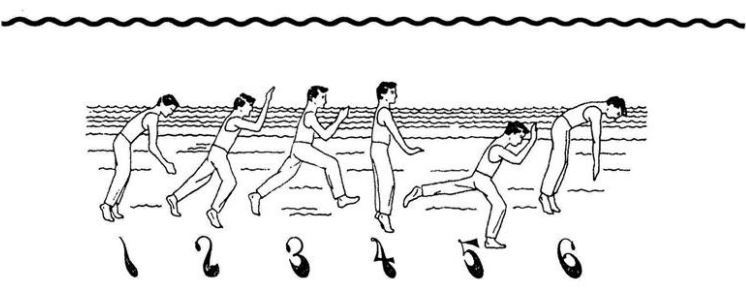Can't Swim? Not To Worry - Drown Proof Yourself! (Part III)
Reprinted from December 1988
by Leonard Hulsebosch
Introduction
The newsletter section of this web site contains 40 years of Houston Canoe Club newsletters. Amidst those many publications are buried a lot of gems of wisdom, that are still just as valid today as when they first appeared. The following article from 30-years ago is one of those gems.
Navy and Coast Guardsmen in basic training are taught the following method;
1. With lungs full of air, float face-down with the back of the neck just breaking the surface of the water. Your full lungs will provide more than enough flotation, even for a natural "sinker". This position is basically the jelly-fish float that is taught to youngsters. Remember, arms and legs should hang freely, exerting no energy!
2. Prepare for a downward thrust using the arms or legs, a combination of one arm and one leg or all four limbs. Many people prepare for a variation of the breast stroke here, which is good if that is comfortable. Your legs should slowly move apart preparing for either a scissor or frog legs kick. At the same time, raise the arms slowly forward or to the sides, whichever position suits you. Your arms will be used to thrust downward.
In all movements, move slowly! Remember: the object is to use the least amount of energy possible. These movements should each take 15 - 20 seconds.
3. Exhale through the nose while lifting your head, and, at the same time,
4. S-L-0-W-L-Y thrust your arms downward or horizontally and bring your legs together.
Not much movement is needed to raise the mouth above the water. Don't try to raise your neck or shoulders above the water. BE SURE to exhale through your nose while it is still in
the water, on your way up. If you exhale too soon, you lose the buoyancy of your lungs. Exhale too late and you waste precious energy keeping your heavy 15-pound head above water. HERE you take your breath of fresh air. If you are in rough water, you may benefit from timing your cycles to use your natural rising and falling with the waves.
5. With your lungs full of air, play dead. Face the bottom of the lake or ocean, drop your arms to your sides and let your limbs hang lifelessly. Depending on your natural buoyancy, and the buoyancy from your lungs, you may take several seconds to bob back to the surface. Some people people must make a second downward thrust or extend the fists to keep from sinking too deeply. Use whatever method is best for your body, and you will conserve energy.
6. The last step is to relax. With head, arms, and legs dangling, hold your breath as long as it is comfortable. It is natural for pressure to build up in your lungs while holding your breath. If you feel this happening, exhale a few bubbles through the nose. After three to ten seconds, start the cycle over.
Each cycle should last from 30-60 seconds, depending on your rest period, how often your lungs need air, and how much energy you have wasted in moving too quickly. The need for a buddy or life-guard cannot be stressed too greatly for those of you experimenting with this concept. For more information on drown proofing, contact your Red Cross, Y.M.C.A. or local colleges and swimming instructors.

 |
| The author, Leonard Hulsebosch |